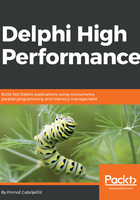
Looking at code through the Big O eyes
We can tell more about the program, about its good and bad parts, if we look at it through the eyes of time complexity, in terms of the Big O notation.
We'll start where the code starts—in the SlowMethod method. It has a loop iterating from 2 to the user-specified upper bound, for i := 2 to highBound do. The size of our data, or n, is therefore equal to highBound and this for loop has time complexity of O(n):
for i := 2 to highBound do
if not ElementInDataDivides(temp, i) then
temp.Add(i);
Inside this loop, the code calls ElementInDataDivides followed by an occasional temp.Add. The latter will execute in O(1), but we can't say anything about the ElementInDataDivides before we examine it.
This method also has a loop iterating over the data list. We can't guess how many elements are in this list, but in the short test that we just performed, we know that the program writes out 13 elements when processing values from 2 to 100:
for i in data do
if (value <> i) and ((value mod i) = 0) then
Exit;
For the purpose of this very rough estimation I'll just guess that the for i in data do loop also has a time complexity of O(n).
In SlowMethod we therefore have an O(n) loop executing another O(n) loop for each element, which gives us a O(n2) performance.
The SlowMethod then calls the Filter method which also contains O(n) for loop calling ElementInDataDivides, which gives us O(n2) complexity for this part:
for i in list do
begin
reversed := StrToInt(Reverse(IntToStr(i)));
if not ElementInDataDivides(list, reversed) then
begin
SetLength(Result, Length(Result) + 1);
Result[High(Result)] := i;
end;
end;
There's also a conversion to string, some operation on that string, and conversion back to the integer StrToInt(Reverse(IntToStr(i))). It works on all elements of the list (O(n)) but in each iteration it processes all characters in the string representation of a number. As a length of the number is proportional to log n, we can say that this part has complexity of O(n log n), which can be ignored as it is much less than the O(n2) complexity of the whole method.
There are also some operations hidden inside SetLength, but at this moment we don't know yet what they are and how much they contribute to the whole program. We'll cover that area in Chapter 4, Memory Management.
The SlowMethod therefore consists of two parts, both with complexity O(n2). Added together, that would give us 2*n2, but as we ignore constant factors (that is, 2) in the Big O notation, we can only say that the time complexity of SlowMethod is O(n2).
So what can we say simply by looking at the code?
- The program probably runs in O(n2) time. It will take around 100 times longer to process 10,000 elements than 1,000 elements.
- There is a conversion from the integer to the string and back (Filter), which has complexity of only O(n log n) but it would still be interesting to know how fast this code really is.
- There's a time complexity hidden behind the SetLength call which we know nothing about.
- We can guess that most probably the ElementInDataDivides is the most time-consuming part of the code and any improvements in this method would probably help.
- Fixing the terrible idea of appending elements to an array with SetLength could probably speed up a program, too.
As the code performance is not everything, I would also like to inform Mr. Smith about a few places where his code is less than satisfactory:
- The prompt How many numbers is misleading. A user would probably expect it to represent the number of numbers outputted, while the program actually wants to know how many numbers to test.
- Appending to TArray<T> in that way is not a good idea. Use TList<T> for temporary storage and call its ToArray method at the end. If you need TArray<T>, that is. You can also do all processing using TList<T>.
- SlowMethod has two distinctive parts - data generation, which is coded as a part of SlowMethod, and data filtering, which is extracted in its own method, Filter. It would be better if the first part is extracted into its own method, too.
- Console program, really? Console programs are good for simple tests, but that is it. Learn VCL or FireMonkey, Mr. Smith!
We can now try and optimize parts of the code (ElementInDataDivides seems to be a good target for that) or, better, we can do some measuring to confirm our suspicions with hard numbers.
In a more complicated program (what we call a real life), it would usually be much simpler to measure the program performance than to do such analysis. This approach, however, proves to be a powerful tool if you are using it while designing the code. Once you hear a little voice nagging about the time complexities all the time while you're writing a code, you'll be on the way to becoming an excellent programmer.